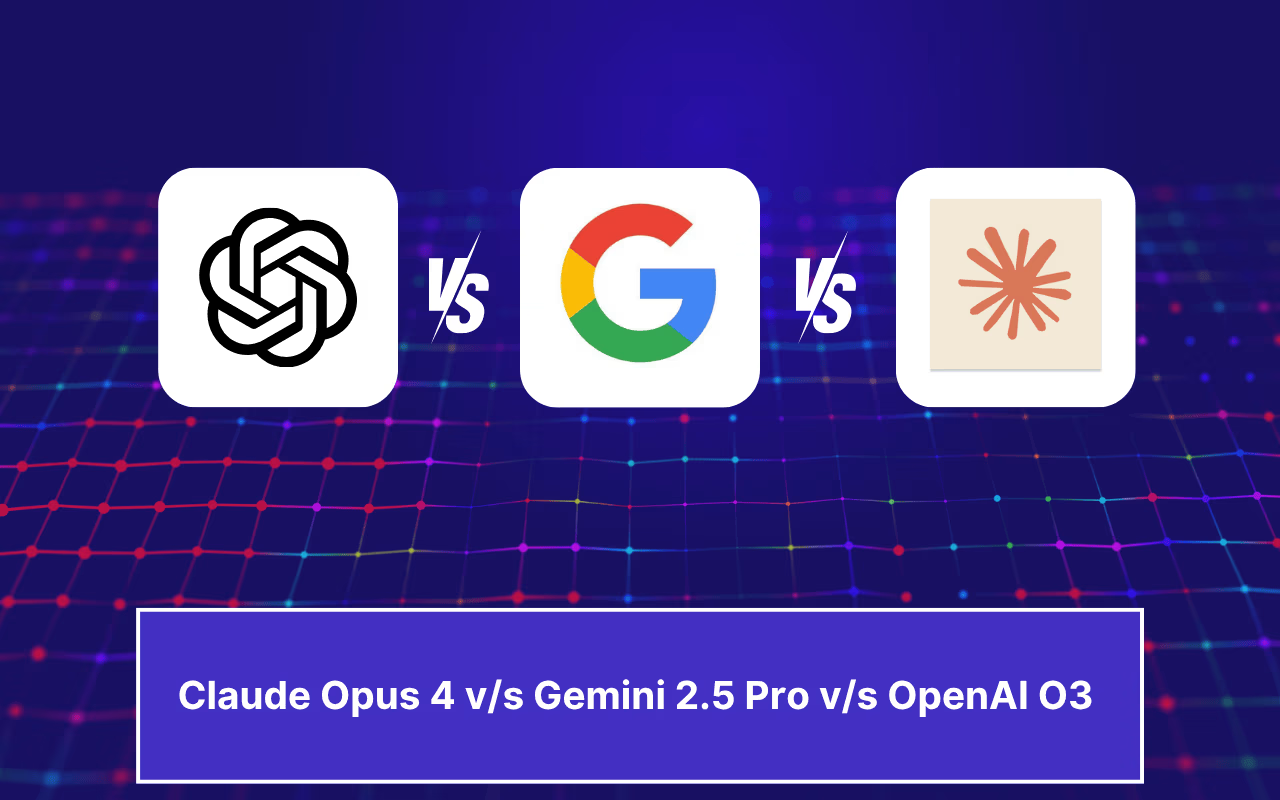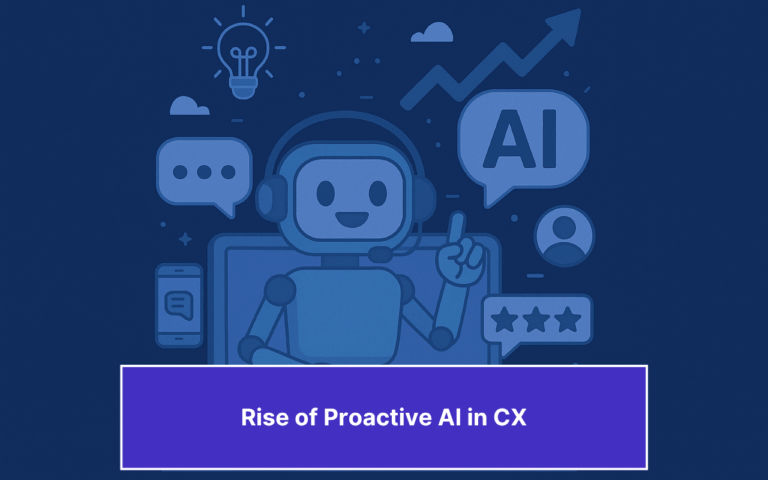Updated on May 28, 2025
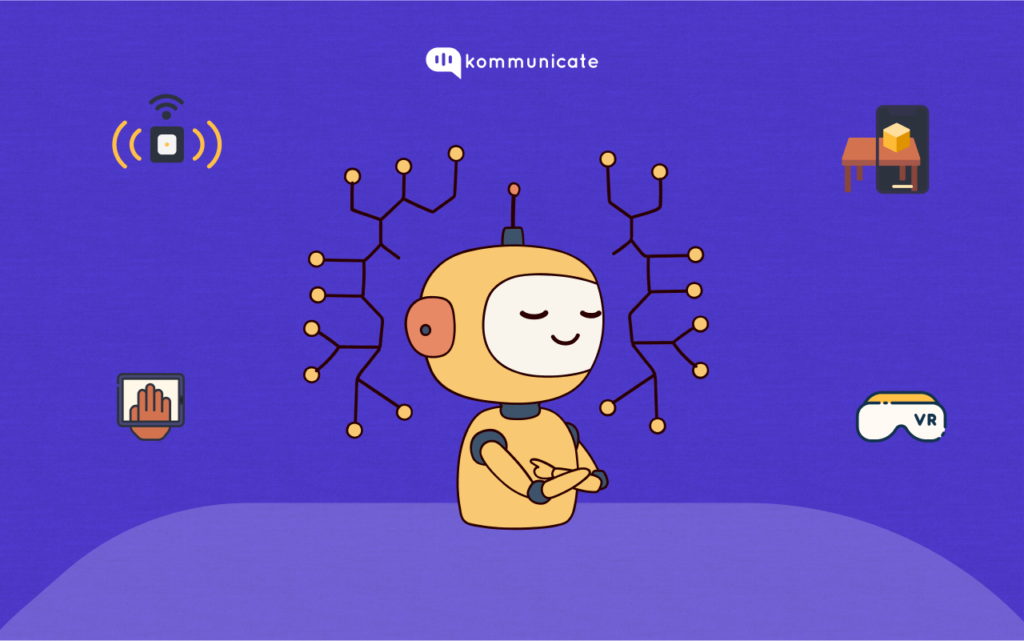
Companies continue to invest in tech and resources, but the struggle to delight customers with exceptional support continues.
For the past several years, most organizations have responded to this challenge by throwing back more and more technology to fix their CX efforts. According to a recent report from Grand View Research, the global CRM market will reach $163.16 billion by 2030. This represents a compound annual growth rate (CAGR) of 13.9% from 2023 to 2030.
So where does it all start?
Where Does Customer Experience begin?
Customer experience begins right from the time they become aware of a brand, even before they consider making a purchase. It includes all of their brand interactions – from initial discovery and research to their evaluation and purchase decision.

Customer experience begins when a customer:
- Sees an ad for a new product on social media.
- Visits a company’s website to learn more about their products or services.
- Reads reviews of a company’s products or services on a third-party website
- Calls a company’s customer service department to ask a question.
- Visits a company’s retail store to try on a product or purchase it in person.
And it’s not like an investment in Customer Experience is a “good-to have.” In the age where 52% of the customers will make a switch to a competitor after just one bad customer experience, investment in CX is a “must-have.”
Here are a few data points to back up that statement:
- A Zippia survey says 80% of the companies that invest in CX have higher revenue.
- Nearly 50% of the organizations that took place in a Gartner poll say they can track the financial benefits of investing in CX projects.
- 72% of the customers who participated in this survey by Zendesk say they want immediate service.
Also Read: 5 Best Ways to Transform Customer Experience in Banking

For companies, it is important that they provide a positive experience at every stage. By prioritizing customer experience from the very first point of contact, companies can leave a lasting positive impression on their customers.
This not only increases the likelihood of a purchase but also sets the foundation for a long-lasting and mutually beneficial relationship.
Challenges in Driving A Consistent Multi-Channel Experience
Delivering a seamless and consistent experience across multiple channels has become a critical aspect of customer engagement for businesses today. According to this survey by Salesforce, a whopping 85% of the people say they expect a uniform customer experience, whether it is in the store or online. Customers expect to interact with brands effortlessly, whether through a website, mobile app, social media, or in-person. However, achieving this level of consistency poses several challenges for the business.
1. Customer Expectations
Customers today expect a seamless experience across different channels. They want to be able to start a task on one channel and pick it up on another without having to start over. They also expect businesses to have a complete understanding of their needs and preferences, regardless of which channel they are using.
2. Silos Within the Organization
Different departments, such as marketing, sales, and customer service, often have their own goals and priorities – this sometimes make it difficult to coordinate efforts and provide a consistent experience across all channels. In fact, 72% of leaders say that merging teams around customer experience will lead to a better operational efficiency.
3. Lack of Data Integrations
Businesses today collect customer data from a variety of sources, such as their website, social media, and CRM system. However, this data is often not integrated, which can make it difficult to get a complete view of the customer and to provide a personalized experience across all channels.
4. Technological Challenges
Implementing and managing a omni-channel experience can be complex and expensive. Businesses need to invest in the right technologies and train employees on how to use them effectively.
5. Measurement and Analytics
Tracking and analyzing customer interactions across multiple channels to gain actionable insights can be challenging. It requires robust analytics tools and strategies to provide a unified view of customer journeys.

6. Content Adaptation
Tailoring content for different channels, without compromising the overall brand message and tone, is a challenge. Content must be optimized for each platform while ensuring a cohesive brand voice.
The first step in overcoming these challenges is to always keep the customer at the centre of all decision-making. Rather than looking at the processes inside out, businesses should see how using a certain technology or process can help their customers in their journey so that they can derive more value from the product.

Artificial Intelligence or AI is one such technology which is being used by many of the companies in addressing some of these problems and providing their customers a superior experience in a multichannel environment round the clock.
Let’s look a little deeper into this in our next section.
AI-Powered Customer Experience
Artificial Intelligence or AI as it is popularly called, has transformed the way a business can engage with their customers today. Leveraging advanced algorithms and machine learning, AI has enabled them to understand, anticipate, and address customer needs in ways that were once unimaginable. From AI chatbots offering instantaneous support to predictive analytics guiding personalized recommendations, AI in customer service has completely revolutionized the customer journey.
Let’s look at some of the areas where AI is playing a key role –
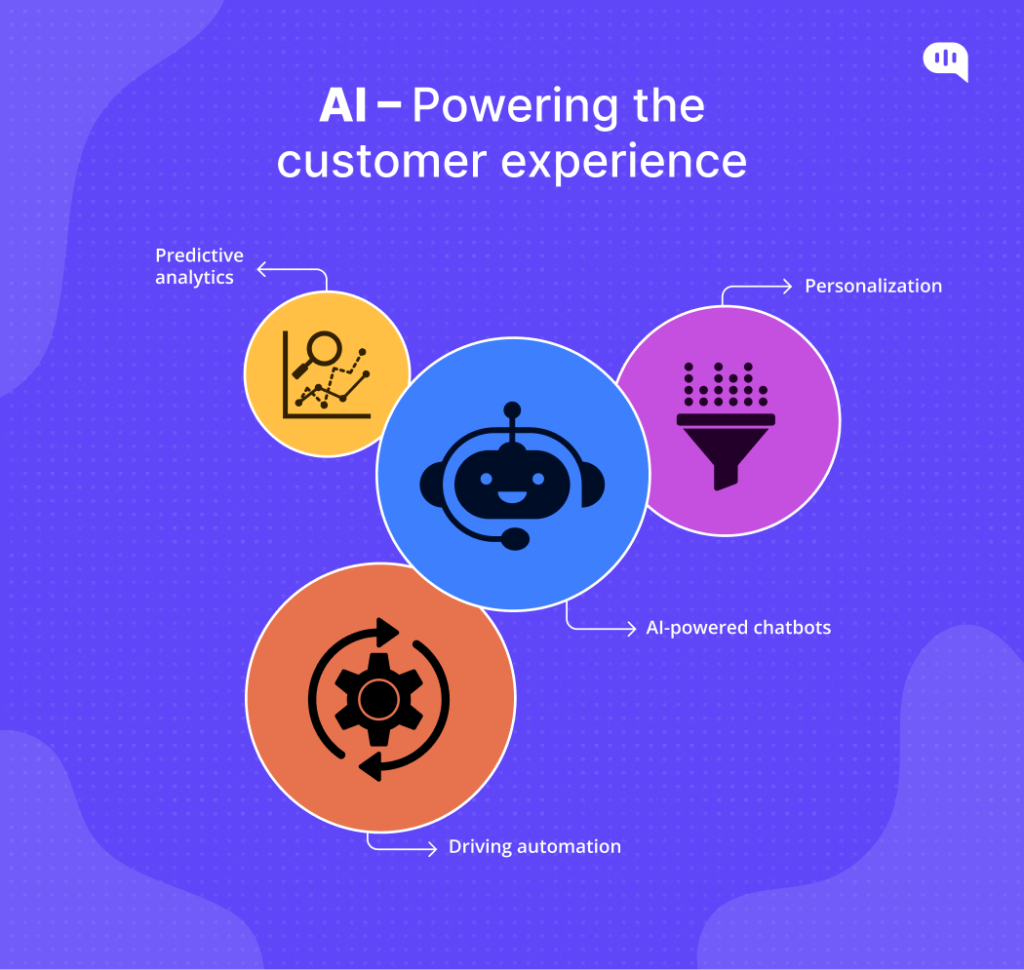
Personalization
AI is helping personalize the customer experience at every touchpoint, from the website to mobile apps to the customer service center. For example, AI can be used to recommend products to customers based on their past purchase history, or to provide personalized support to customers who are having problems.
Driving Automation
By automating repetitive tasks, such as answering customer questions or processing orders, AI helps in freeing up time of support agents and allows them to focus on more complex issues and provide a more personalized experience to customers.
Predictive Analytics
By analyzing the customer interactions across all the touch points, AI in customer service is able to share deep insights into customer behavior and helps in identifying potential problem areas which might lead to customer churn. This allows businesses to take proactive steps to prevent problems from happening and retain their customers.
AI-powered Chatbots
AI-powered chatbots can provide 24/7 customer support and answer customer questions quickly and accurately. This helps businesses in reducing customer wait times and improve the overall customer experience. In fact, according to this IBM report, businesses spend over $1.3 trillion to address customer requests, which chatbots can reduce by 30%.
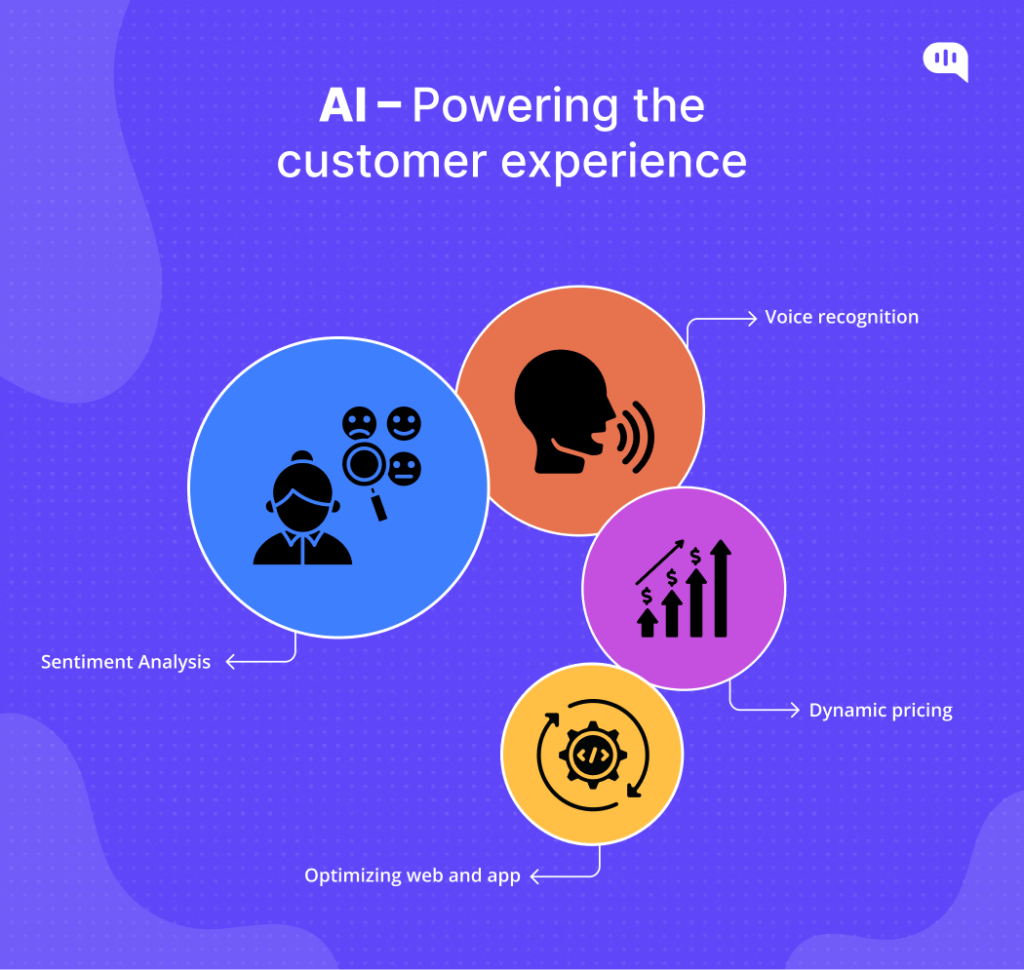
Sentiment Analysis
AI can analyze customer feedback , chats and other social media interactions to gauge the sentiments of their target users and thus helping companies to run targeted campaigns and derive maximum value.
Voice Recognition and Assistance
AI-driven voice assistants like Siri and Alexa provide convenient ways for customers to interact with brands through voice commands. This Think With Google Report, in fact, says 20% of searches in the Google App are now done by voice.
Dynamic Pricing and Offers
With its sophisticated processing abilities, AI helps businesses to automatically change prices and offers in real-time, considering factors like demand, competitor pricing, and customer behavior.
Optimizing Website and App Experiences
AI-driven tools such as Hotjar, Google Optimize, Crazy Egg helps businesses in analyzing user behavior to improve website and app navigation, content placement, and overall user interface.
While AI in customer service is turning out to be one of the good friends for businesses when it comes to driving better customer experience, it also comes with certain risks that have to be kept in mind.

Potential Risks of using AI in CX:
Here are some of the pitfalls of using AI in customer service:
1. Technological dependence
Customer support agents being heavily dependent on AI is never a good thing. It may lead to the degradation in the quality of customer support that they deliver. If the AI systems fail, it can lead to some serious repercussions. This is why there must be a right balance between AI and human agents to ensure continuity.
2. Increase in implementation costs
According to a report by Mckinsey, the initial cost of integrating AI into customer service can go up as high as $1 million. This kind of money is unimaginable for smaller businesses, and they may struggle to compete with bigger enterprises.]
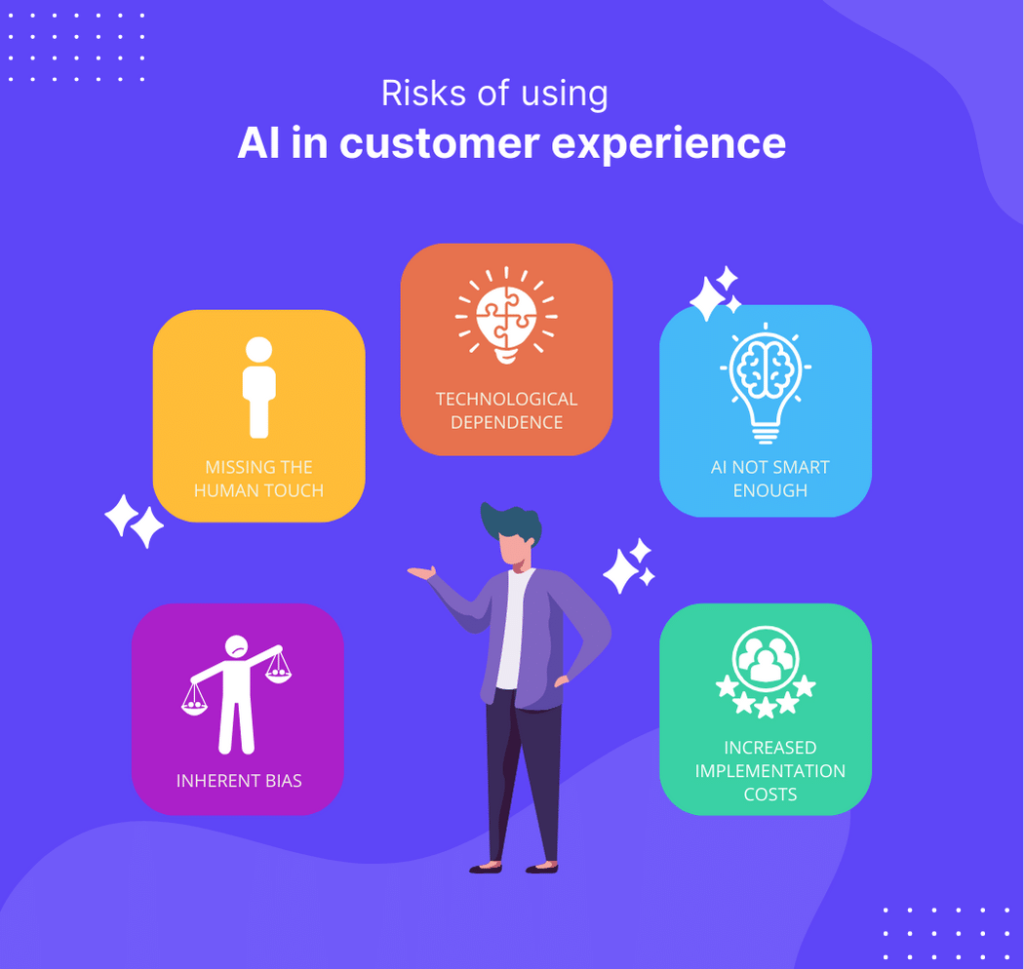
3. AI Not Being Smart Enough
Although AI’s problem solving capabilities are advancing by the day, there is still a lot of ground that AI can cover. Chatbots driven by AI often struggle with unique customer queries, and this can lead to frustration among customers.
4. Inherent Bias
There is an inherent bias in AI tools like ChatGPT, because their training happens on large datasets which humans enter. AI can perpetuate this bias and create discriminatory outcomes, which certain customer groups may not take kindly to. It can seriously impact your brand image, and can also lead to a lawsuit if not checked at the right time.
5. Missing Human touch
According to this survey by Userlike, 60% of the people participating in the poll say they will wait in line for an agent, if it means they can talk to an actual human being. No matter how advanced AI chatbots are, delivering the best customer experience still requires a human touch. AI can handle complex tasks, but it lacks empathy and understanding complex emotions. This leaves customers dissatisfied.
How to Use AI for Better Customer Experience
Adopting AI for customer experience doesn’t require a complete tech overhaul. With a strategic approach, businesses of any size can begin transforming support with AI tools. Here’s a step-by-step guide:
1. Identify Customer Experience Pain Points
Start by auditing your current support system. Are customers waiting too long for responses? Are FAQs overwhelming your agents? Do customers drop off before completing tasks? Pinpointing these challenges helps you decide where AI customer service can have the most immediate impact.
2. Choose the Right AI Customer Service Platform
Not all platforms are created equal. Look for tools that offer:
- Multichannel support (website, apps, messaging)
- Easy integration with your CRM and helpdesk
- No-code chatbot builders to accelerate setup
Platforms like Kommunicate allow you to deploy AI-powered chatbots with minimal technical effort while keeping CX consistent.
3. Train Your AI with Relevant Data
AI becomes smarter with better data. Upload historical support conversations, knowledge base articles, and FAQs to ensure the bot understands your product and customers. Use intent training and keyword mapping to refine responses.
4. Blend Automation with Human Touch
Use AI to handle routine queries like order status, appointment bookings, password resets, while seamlessly handing off complex issues to human agents. This hybrid approach improves efficiency without sacrificing empathy.
5. Personalize Customer Interactions
Modern AI customer service platforms can access customer histories and preferences. Use this data to:
- Offer tailored product recommendations
- Continue past conversations across devices
- Greet returning users by name
Personalization drives loyalty and makes customers feel valued.
6. Monitor, Measure, and Iterate
Track key customer experience metrics:
- First Response Time
- Chatbot Containment Rate (how many queries AI resolves without human input)
- Customer Satisfaction (CSAT)
- Resolution Time
Regular reviews of these metrics help fine-tune the AI and unlock more CX improvements over time.
7. Scale with Confidence
Once your AI proves successful in one area (e.g., customer support), expand it to other areas like onboarding, feedback collection, and proactive engagement. With each touchpoint AI enhances, the overall customer journey improves.
So, the ideal solution to solve the customer experience puzzle?
We believe that it lies in a potent combination of AI and human touch, where the human-hand off happens at the exact moment a customer is starting to feel the disconnect. A powerful AI tool such as a chatbot can be the perfect solution, if you want to deliver a uniform experience across all the channels.
Chatbots can work across different channels, can be multilingual, and provide the requisite response in the least amount of time. They also never get tired, go on bathroom breaks or vacations, and do not mind answering repetitive queries.
We hope you now know how important it is to deliver a uniform customer experience, and the different ways to do so. In spite of the pitfalls of using AI in delivering superior CX, AI will continue to play a critical role in all customer interactions with a business, as it improves over time. So the best way to go forward, in our opinion, is to embrace it and see where the journey takes you.

At Kommunicate, we envision a world-beating customer support solution to empower the new era of customer support. We would love to have you on board to have a first-hand experience of Kommunicate. You can signup here and start delighting your customers right away.
As the Head of Growth, Marketing & Sales, Yogesh is a dynamic and results-driven leader with over 10+ years of experience in strategic marketing, sales, and business development.

